Please use the following link to download the October 15, 2022 issue of the syəcəb
Category: Tulalip News
Ten years of videography and culture
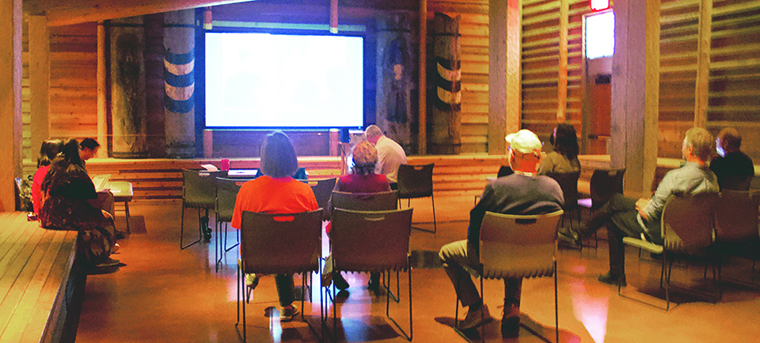
By Shaelyn Smead, Tulalip News
Filmmakers, creators, and artists gathered at the Hibulb Cultural Center on October 8 for the 10th Annual Film Festival. With nine Native and non-Native films, ranging from animation, music videos, drama, and documentaries, the festival delivered a diverse collection for all to enjoy.
Created in 2012 by Hibulb Cultural Center Education Curator Lena Jones, this year’s film festival theme was Healing Generation to Generation. It is a concept centered around generational healing and recognizing those that provide hope for the future.
Honoring the theme, a couple of standout films were ‘We Still Live Here’ by Anne Makepeace, which follows Wampanoag social worker Jessie Little Doe and her journey to reviving the lost language of her people, and ‘From Programs to Pilgrims’ by Simme Bobrosky. The film portrays Simme’s discovery of her Ukrainian roots and familial journey into America. She used old photos of her family and animated them to look alive as if they were speaking into the camera.
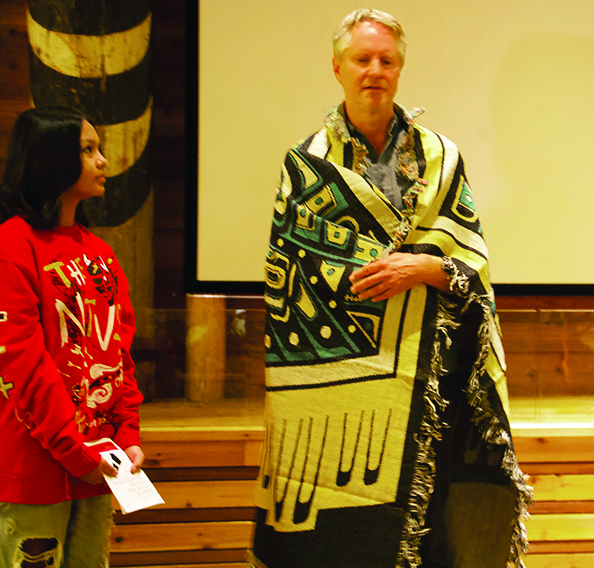
Two cinematographers were honored with the Lifetime Achievement Award, Robert Lundahl and Eero Johnson, during the event. Each award winner shared information about their works and the different inspirations they derived from.
Robert received recognition for his role in regional, cultural, and environmental sharing. His film “The Burden of Proof,” based on the use of Agent Orange in national forests, was used as a demonstration screening for a U.S. Senate subcommittee about the environment. He also created “Unconquering the Last Frontier,” which was filmed in Washington and based on the salmon crisis within the Pacific Northwest. It centered more specifically on the Elwha River and its removal.
Eero received recognition for Coast Salish cultural sharing and storytelling. Throughout his career, Eero has maintained a close connection to Indigenous people. He has worked closely with Tulalip Media and Marketing and worked for Northwest Indian News. He spent several years following the canoe journey and shared the many stories of canoe families. He produced many pieces centered around popular Native artists, painters, performers, and carvers. He also created films involving issues like Treaty Rights, the Boldt decision, and Residential Boarding Schools. His countless efforts to share the perspectives and stories of Native American people made him an ideal candidate for the theme and the Lifetime Achievement Award.
In his thank you speech, Eero said, “Twenty years ago, when I started working with Indigenous people, it was a turning point for me professionally and personally. It was a chance to visit a place I ordinarily wouldn’t have gone to, be involved in events I wouldn’t have known about, and meet some amazing people. One of my first stories was about the Cushman Boarding School, and it’s sad to say, but in my non-Native upbringing, I didn’t know any of the history until I found myself doing this work. This has been a journey of learning about pieces of history that deserve to be talked about.”

The Film Festival judges consisted of film advisor Antonia Ramos (Tulalip), filmmaker Mike Van Luvan, and Native radio Host/Producer Robin Carneen (Swinomish). Each submission to the film festival was reviewed by the judges and nominated for an award. The awards varied from best feature, best music composition, best acting male/female, best experimental, best directing, etc. Judges are asked to pay close attention to and judge based on script, creativity, coherence, meaningfulness, and editing.
In addition, a special emcee was introduced to this year’s festival, “This year, we were very fortunate to have Tulalip’s own Faith Iukes emcee our event. We’re very grateful there are youth willing to help make our film festival successful,” Lena said.
Hibulb staff encourages all filmmakers to participate in the film festival. If you or someone you know is looking to submit for the next film festival, please call the cultural center at (360) 716 – 2600.
2022 Film Festival submissions:
- ‘It Gets in Your Blood’ by Ed Hartman
- ‘Starlight’ by Ed Hartman
- ‘From Programs to Pilgrims’ by Simme Bobrosky
- ‘Tough Love’ by Ryan Craig
- ‘Dreams on the Duwamish’ by Elke Hatula and Michael Kleven
- ‘The Train I Missed’ by Elke Hatula and Michael Kleven
- ‘We Still Live Here’ by Anne Makepeace
- ‘For Sale’ by Melinda Raebyne
- ‘Walrus Skin Boat’ by Robert Lundahl
Resolving trauma with Frank Grijalva
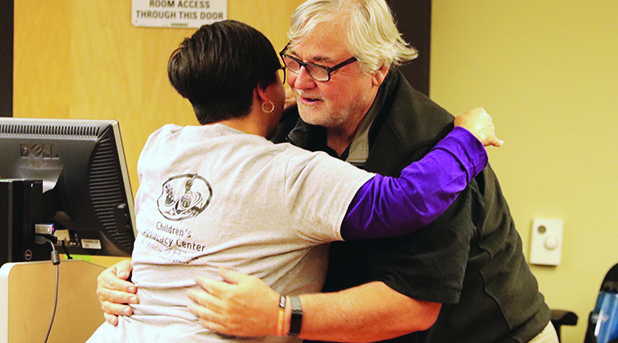
By Kalvin Valdillez, Tulalip News
Recently, the Tulalip Tribes held the second annual community gathering in recognition of National Residential Boarding School Awareness Day. This year, the event brought out hundreds of tribal members and community members in an effort to bring attention to the truth about the terrible actions that occurred during the boarding school era. And equally important, the gathering presents an opportunity to start the healing process from that trauma, which has been passed down through the generations.
Now that many are beginning to understand what generational trauma is and how it affects Native America, as well as themselves personally, they want to take action. There has been a concentrated effort amongst tribal nations to identify what their people’s traumas are and how to address it now, so our future tribal leaders do not have to live through the number of struggles that came before them.

Generational trauma affects not only the community, but the individual homes of each tribal member as well. Our habits, behaviors, decision making abilities and trigger responses are all results of our trauma, as is our physical and spiritual well-being. As Native people, our trauma might look like substance abuse, depression, suicide. Trauma does not only affect the individual, but also the people they are surrounded by, such as their children, spouses, and their extended family, and community. And although not always, trauma can often lead to domestic violence (DV) situations inside the household.
Tackling the issue head-on, following the healing experience from the September 30th community gathering, the Legacy of Healing (LOH) hosted a two-and-a-half-hour workshop on October 6th at the Tulalip Administration Building. The workshop was focused on resolving trauma and served as the kick-off event for National Domestic Violence Awareness Month, and approximately twenty community members took part in LOH’s first event of the month.
“The traumas that we experience are a direct link to the domestic violence that people also experience in their lives,” said LOH Director, Jade Carela. “I believe that a lot of it stems from the trauma that we’ve had in our lives and the things that we learned growing up.”
The informative and insightful workshop was led by the Director/Consultant of the Midwest Trauma Services Network, Frank Grijalva MSCC, MSPH. Frank has been in the Tulalip and Marysville community for several years and has worked with the Tribe’s education division, the community health department, and also the Marysville School District.
Frank’s presentation gave an in-depth look at what trauma is and how it rewires our brains and central nervous systems. He spoke about how trauma plays a role in the early childhood development stages and how some traumas are passed along before the birthing process. Throughout the workshop, he took plenty of time to pause to see if the people were following along and if there were any highlights or topics they could relate to in their own homes and families.
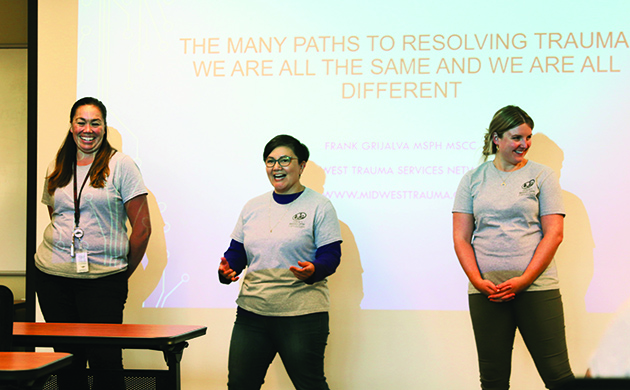
Frank said, “What we did in the boarding schools three generations ago, is we fractured all the families. So, auntie wasn’t there to pick up the baby when the baby was too much for the mom. Or sissy, cousin, grandma, or whoever wasn’t there to take over, to pass the baton to, so their mom could get some rest. Everywhere I go, it’s grandparents who are taking care of the kids because so many kids in this generation have lost themselves, lost their ability to attach and stay in rhythm and be vulnerable, and to stay in love and stay connected.”
After taking time to discuss what trauma is, and what it looks like at Tulalip, Frank explained that people can begin the work of healing their trauma wounds, and over time they can rewire their brains and central nervous systems, essentially becoming an entirely new person with a new outlook on life.
“Indigenous practice knows more about what it’s doing than the colonized practice,” he stated. “Colonizer practice wants to use pills, talk therapy, and all these cognitive engagement processes. The human being who is traumatized is compromised and changed; their central nervous system, their brains, the way that they perceive the future, their access to narrative, their access to comprehension, the way they think about things linear and logically, those are all altered. And the practice of wrapping around, nurturing, ritual, connection, consistency, and nourishment, all of these things that are meant to address the whole human being, are actually the things that are most useful in trauma resolution.”
Frank continued, “For a lot of people, I ask what your baseline heart rate is. It’s too high if it’s over eighty, unless you’re on some type of medication. The only way you bring your baseline heart rate down is by doing a grounding practice, an internal practice. It could be drumming, dancing, sweats, smokehouse, it could be sitting and looking at nature, it could be yoga. The metaphor I always use is driving a car. Remember when you first learned how to drive and how scary it was? Merging into traffic at 70 mph, all of that. And now, you’re probably driving to work, and you don’t even think about it. You didn’t get that way by avoiding it, you got that way by going head-on with it and working on it.”
Workshop attendees were treated to a spaghetti dinner while Frank gave his presentation, and upon entering room 162, they received notebooks with resources for DV victims, and LOH heart-shaped stress balls. They also had the first opportunity to enter the LOH’s DV Awareness Month raffle, which includes prizes such as an 18-inch hand drum by Les Parks, art and photography by Tribal member Monie Ordonia, beaded earrings and much more.
And just as an FYI, the LOH will be holding pop-up events on Fridays throughout October at the Tulalip Administration Building from 12:00 p.m. – 2:00 p.m. by the café, ti kupihali. All proceeds from the raffle will go towards supporting survivors of intimate partner domestic violence and the tickets are $5 each or five for $20.

To end the workshop, the LOH asked several individuals what they took away from the workshop. Each person who volunteered to share received a sage and smudge kit.
“I find a lot of what Frank talks about really interesting,” said Tribal member, Marc Robinson. “What I try to do personally is to understand what everybody and their reactions are, and how they walk about in their everyday lives. I am a student advocate at two middle schools and two elementaries. What I like to do is build that relationship and try to understand the triggers the students may have for their behavior outbreaks. I try to be that person who bridges the gap between admin, teachers, and the staff so I can advocate for the student. Understanding trauma for me is really interesting and helpful both personally and professionally.”
Following the workshop, Frank expressed a desire to hold more trauma classes in the community. He stated, “I think we need to do it more frequently because human beings who are struggling, they don’t often hear the message the first time, second time, or third time because they got their own stuff going on. We have to make sure that we are doing this with a frequency that more people can come to the table and bring their own lived experiences because we are a learning community, we are learning about this together. I don’t know the Tulalip tribal trauma, I know the science of trauma and I know my own journey through it, and the more people I can learn from here, the better practice I get to help build the program. My office is at the youth center, and I meet with people individually as well as with families; psycho-educating, problem solving, coaching, I do a variety of things.”
As Frank mentioned, he can be reached at the Tulalip Youth Center at (360) 716-4909. Please reach out to him for further details regarding trauma and how to begin your healing process.
The LOH’s DV Awareness Month continues with weekly events that are scheduled to be held in room 162 of the Tulalip Admin Building. All the events begin at 5:30 p.m. and are listed below.
- Thursday, 10/13: Self-Defense Class (ADULTS ONLY – limited to first 20 people only. E-mail CRae@TulalipTribes-nsn.gov to register)
- Thursday, 10/20: Sisters Rising Film Screening (ages 14+)
- Tuesday, 10/25: Beading as Healing Class (Wear Purple Day)
After witnessing the turnout for the first DV Awareness Month event, Jade expressed, “This shows that our community is ready. They’re ready to heal and ready to learn. They’re ready to start being vulnerable with each other and ready to start learning how we as a community can heal together. I’m really excited for this month, and I hope more people can join the different events that we have going on.”
If you or anybody you know is experiencing an abusive relationship, please do not hesitate to call the LOH at (360) 716-4100 for assistance. And if you are in a crisis or an emergency situation, the LOH provided a list of three additional hotline numbers that you can utilize during your time of need:
- The National Domestic Violence Hotline 1-800-799-SAFE (7233)
- Strong Hearts Native Helpline: 1-844-762-8483
- Domestic Violence Services of Snohomish County 425-25-ABUSE (22873)
Celebrating Indigenous Peoples, the Daybreak Star way
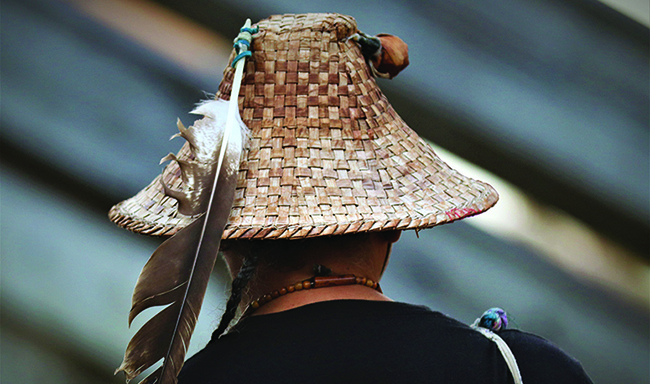
By Micheal Rios, Tulalip News
For the eighth consecutive year, the greater-Seattle area and its tens of thousands of proud Native American citizens celebrated Indigenous Peoples Day. Replacing the former misbegotten holiday dedicated to a slave trader and lost Italian navigator, the commemorative day to honor the past, present and future of Indigenous culture takes place annually on the second Monday in October.
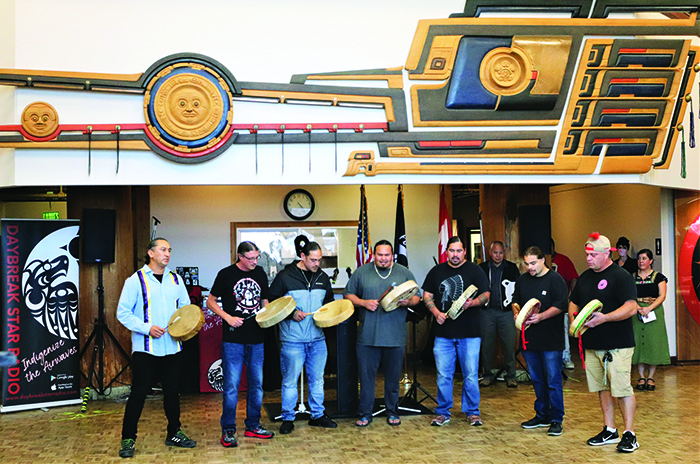
“People ask, ‘Why Indigenous Peoples Day and why not American Indian Day or Native American Day?’ It’s only appropriate that we honor the legacy of work that’s been done,” explained educator Matt Remle (Lakota). His efforts, along with many other Native activists, were instrumental in getting a proclamation voted on by the Seattle City Council and signed into law by then-mayor Ed Murray in 2014. “It’s not only honoring legacy, but when we say ‘Indigenous peoples,’ it’s referring to more than just the tribes of the colonized United States. We’re talking about all Indigenous peoples who’ve been impacted by settler colonialism around the world.”
Since its inception into Puget Sound lexicon, the Indigenous Peoples Day movement has spread to hundreds of cities across the nation. It’s been formally adopted by 19 state governments, and even universities and entire school districts are now indoctrinating the day to celebrate global Indigenous cultures into their holiday calendars.
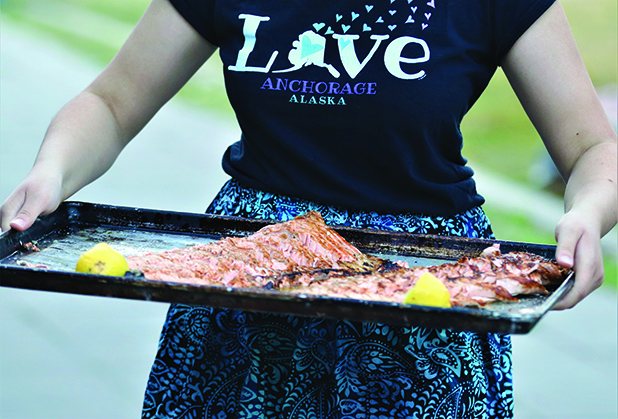
On Monday, October 14, Native people and their allies from around the Pacific Northwest gathered at Westlake Park, on ancestral Duwamish land, for a march and rally to celebrate Indigenous Peoples’ Day in Seattle. The dedicated early morning group proudly wore cultural garb and traditional regalia while traversing from Westlake Park to Seattle City Hall, where a rally of celebratory song and dance was held.
“I love this moment. Feeling my drum vibrate through my soul, out of my feet into Mother Earth, and back up into my body,” shared Sarah Hart (Tulalip) after marching through Seattle’s urban landscape. “Empowering is an understatement. Being who we are as [Native] people is a way of life, it’s every aspect of who we are and it’s in every fabric of our being. We don’t celebrate the genocide of our people, we celebrate who we are as people. We celebrate together. One heart. One drum. One voice. Together.”
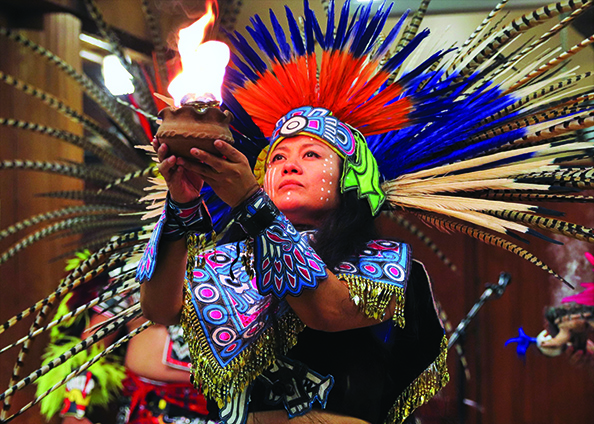
Hours later, the festivities continued at Daybreak Star Cultural Center with a host of activities intended to celebrate all the sovereign nations that comprise the Puget Sound region, known colloquially as Coast Salish territory. Sponsored by the United Indians of All Tribes Foundation, the Daybreak Star gathering included hundreds of urban Natives, culture bearers from a variety tribal community, and non-Natives who wanted to share in the memorable event.
The American Indian Movement honor song was an appropriate opening the evening’s event.
Quick history lesson. Daybreak Star was built on what was formerly a decommissioned Fort Lawton army installation. On the morning of March 8, 1970, a convoy of vehicles reached their destinations, both the north and south sides of Fort Lawton, when the occupants of the cars launched a coordinated effort to occupy the fort and establish it as a cultural and social services center for Seattle’s growing Native American population. In the midst of the ensuing struggle, the occupation’s principal organizer Bernie Whitebear stated, “We, the Native Americans, reclaim the land known as Fort Lawton in the name of all American Indians by right of discovery.”
The Native activists who invaded Fort Lawton that day were ultimately successful in their goal of establishing an urban Indian cultural center at the site. While similar centers already existed in San Francisco, Minneapolis, and New York, what was to become Daybreak Star Center was the first to be established through militant protest. *
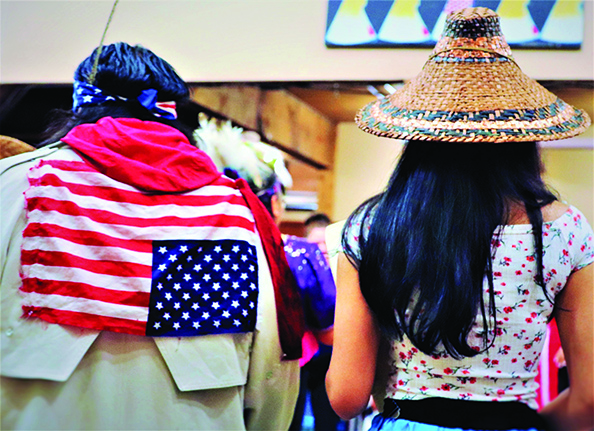
Fifty-two years after that legendary occupation, the American Indian Movement (AIM) anthem rang out on the reclaimed grounds of what is today Daybreak Star. Elder Randy Lewis (Colville) is one of the last remaining ‘fence jumpers’ who protested side by side with Bernie Whitebear. He took to the mic following the AIM anthem and said, “Why are we here? Take a look around you. See all the beautiful people wearing their traditional regalia and symbols of their ancestors. See all the happy children running around outside. They are living resistance and don’t even know it. That is why we are here.
“For those of us who occupied Fort Lawton on that day in 1970, this was our dream. To claim a space, a piece of this land, for Native people. To create a house where we can come together and be in community through our shared culture,” he continued. “The wood used to build this building come from local Tribes. The first wood logs brought in were from Colville, then Red Cedar from Quinault, and cross beams made from Snoqualmie spruce trees. Some of the trees go back to the year 1268. Let these trees be a reminder of the sacrifices required by so many that allow us to thrive today.”
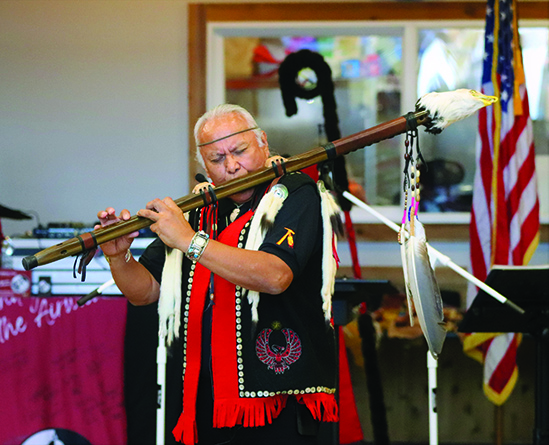
A series of high-energy cultural offerings, representing Indigenous communities across the Americas, kept the multi-generational audience engaged well into the evening. There were many tribal songs with accompanying drum, the digital beats of DJ Big Rez and a mesmerizing Aztec fire dance One particularly standout performance occurred when the overflowing Daybreak Star crowd was treated to several songs and stories offered up by enchanting flute player George Montero (Tlingit).
There were gift bags of traditional medicines, artworks of all mediums, and an appetite quenching plate of salmon accompanied on a bed of wild rice pilaf given to event attendees.
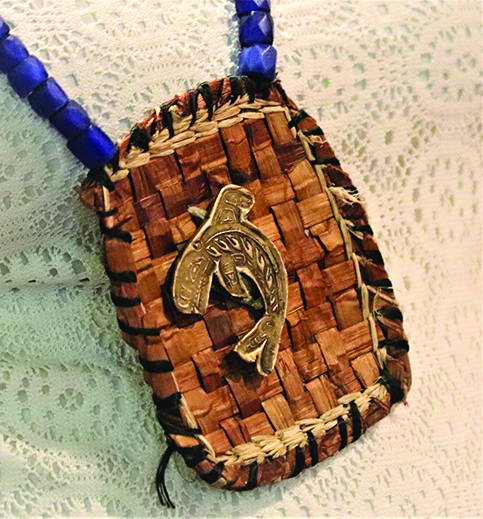
“At its core, Indigenous Peoples Day aims to celebrate and honor the past, present and future of Native peoples throughout the United States. It also served to acknowledge the legacy of colonialism that has devastated Indigenous communities around the globe historically, while continuing to negatively impact them today,” summed up Remle. “More importantly, Indigenous Peoples Day moves beyond the classic narrative of oppression and instead honors the histories, cultures and resiliency of contemporary Native peoples.”

Every day is a great day to be Indigenous. It’s just a little more meaningful when surrounded by family and friends united in common cause – celebrating Indigenous Peoples Day.
Source: https://depts.washington.edu/civilr/FtLawton_takeover.htm
October 8, 2022 syəcəb
Please use the following link to download the October 8, 2022 issue of the syəcəb
Tribal youth are in need of tribal homes
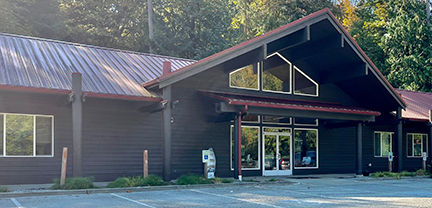
By Shaelyn Smead; photos courtesy of Delia Williams and Theodore Sam
Helping beda?chelh is essential for at-risk tribal youth
The beda?chelh department is in desperate need for respite care workers (daycare) and placement homes (fostering). Unfortunately, with very few tribal volunteers, many of the cases are forced to lean on state-sourced foster resources and non-tribal homes. Leaving a lot of questions and concerns about where these children will end up, and how they will remain connected to the tribe and their culture.
The process for beda?chelh to locate a respite care provider or placement home can be quite grueling. They create a list of family members related to the child and anyone who is 18 years old or over will be contacted and asked if they would be willing to step up and take in their family member.
Tribal member and beda?chelh Placement Specialist Delia Williams who is on the frontlines and helps make these phone calls, said, “Our whole goal is to try and keep our kids here with us. We want to keep families together, but it’s sad because 97% to 98% of the time, these family members will say no. They either aren’t willing or aren’t able to take their family in.” At which point, beda?chelh continues down the list to see if there are any other tribal homes that would be willing to help. After finishing these efforts, and they aren’t able to place into a tribal home, that is where beda?chelh is cornered and forced to utilize State-sourced foster homes.
The reality of having laws like the Indian Child Welfare Act of 1978 and the 1989 Centennial Accord, can be a double-edged sword. The laws have allowed for tribes to maintain jurisdiction over at-risk tribal youth and their wellbeing. Creating a separation between state programs like Child Protective Service and the beda?chelh department. However, it is also up to its tribal members to support the system that is in place and provide services that would otherwise be available through the state. In other words, if there are no tribal respite care workers or tribal placement homes available, then the department is forced to outsource to State and non-tribal workers and homes. At which point, a tribal child could end up living anywhere within the state of Washington, and could be hundreds of miles away from their people.
Why are tribal members skeptical of beda?chelh?
To some, it might seem like simple math. If tribal members want to keep their youth close to their community, they must be willing to open their homes and support their lost cousins, nieces, nephews, etc. So why is beda?chelh struggling to find tribal volunteers?
For some tribal members, it’s the concern that they would be opening up their home to futures investigations and the threat they might have their own kids taken. For others, it’s the risk of behavioral issues that at-risk youth could bring into their home could have an effect on their other kids. Some families feel as though they might not be able to financially afford the costs that come with taking in another child. And for some, it’s simply living in a small community and knowing the backlash they might be facing from their peers.
How is beda?chelh tackling these concerns?
Delia talked about how the department handles some of these concerns. “In any case where a volunteer has a child in their home and in their care, we do a background check, and run a home study to make sure the home is safe, clean, and able to take care of a child. In other cases, where the volunteer just babysits in the family’s home, it doesn’t require a home study. Still, the background checks only go back as far as six years, this allows for tribal members that only have mild records, the opportunity to still volunteer and help,” she said.
When discussing the extrinsic nature of the volunteer respite care or placement position, Delia illustrated that visits from the beda?chelh social worker are only about once a month, just to ensure the well-being of the tribal child. Other than that, the social worker is also helping remind the volunteer of upcoming cultural events that the tribal child can attend, to observe cultural practices, providing sport and extracurricular opportunities, and resources that the child may want/need. These visits are also an opportunity to check on the mental and emotional state of the volunteers in making sure that they are doing okay with their transition. The social worker will then provide the volunteers with any assistance they may be needing as well. If there is a point in which the volunteer feels overwhelmed, they also reserve the right to forfeit their services.
Some families fear that by opening up their home, they risk beda?chelh potentially taking their own kids away from them. Delia spoke that a situation like this would only occur in severe cases that required it. Even then, in her experience she has not witnessed this happen.
Delia said, “If we notice a respite care worker, or placement home provider struggling in any way, we want to help. We know the sacrifices that these people are making, and we want to help our tribal youth as much as possible. Whether we’re helping guide them to programs, or grants, our goal is to help these providers, not hurt them. By helping them, we are helping our tribal kids.”
There is compensation available for respite care workers and/or placement homes. Once a home study and background check has been conducted, and care services have been designated, then compensation will become obtainable. Respite care and family grant amounts vary applicant to applicant.
Money aside, there is still the fear of backlash that a respite care worker or placement home fears. Beda?chelh does ensure confidentiality with every case, however with the coming of social media and living in such a small community, sometimes being anonymous on paper, doesn’t help the reality of the world. Word travels fast and sometimes your services become public knowledge.
One thing that Delia said in regards to this was, “Ultimately these families that are helping only have to tell people what they feel comfortable with. There’s not much we can control when word starts spreading, but I encourage our volunteers to feel comfortable enough to just own it. They’re doing something great for our community and not a lot of people would be willing to do what they’re doing. Every time someone steps up to help a tribal child, it sows that seed that our community is willing to help each other.”
This same backlash is unfortunately what employees within the department face, and Delia deems the reason as to why is there aren’t as many tribal employees working for the department as there should be. “Our people are just as scared and intimidated sometimes by the retaliation we face,” she said. “But we know what is going on with these cases, and we support the decisions that our tribal and non-tribal coworkers make.”
Families that have gone through beda?chelh intake
Unfortunately the beda?chelh department also simply doesn’t have a great relationship with many tribal members and there is a level of distrust. Those families sometimes even speak very publicly about their difficult experience, which in turn carries out a negative perception of the department.
One person who has posted on social media frequently about their experience and has shared her story is Skyla Henry. In 2015, Skyla and her husband struggled with addiction and separated from one another. Skyla’s mother realized all that was going on and took in their kids and raised them for some time. Skyla’s addiction grew deeper and resulted in her being put into prison. During which, life became too difficult for Skyla’s mother, and the kids ended up in beda?chelh’s care, and placed into a home. Years went by as the parents struggled with their sobriety, and the case subsequently closed. Skyla’s husband is now two years sober, and Skyla is four months sober. Now with the two being back together, sober, in a home and working, the couple is anxious and wondering what possibilities there are to be back in their children’s lives. With the case being closed three years ago, it leaves a lot of questions for them.
“I’m really upset because I want some answers,” said Skyla. “I know I haven’t been in my kids’ lives for a long time, and I appreciate all that the placement family has done for them, but you can’t fight the bond between parents and their kids. I just want to know what options I have and what possibility there is for us to be in their lives, even if it’s just visitation. It’s the emptiest feeling in the world being so close to my kids, knowing I could run into them anywhere but not being able to see or talk to them.”

Another tribal family shared a similar story. Theodore Sam struggled with addiction. His four kids were not living in a stable home, and were missing frequent amounts of school. When Theodore first encountered beda?chelh, they were at the beginning of their investigation. “They were coming by and offering different treatment plans and services and were trying to help us. Beda?chelh wanted us to get better, but I didn’t want to receive help,” Theodore said.
Unfortunately, after spending time with the children’s mother, and the parents still struggling with their addiction, the case was taken to Tribal Court and the children were placed into placement homes. At this point, Family Wellness Court provided resources that Family Services has and a case manager stepped in with IOP support, helping Theodore find a home, and create goals and a game plan to get his kids back. Theodore was able to keep contact with his children during that time, but he knew that he needed to do more.
After some time, hard work and dedication, Theodore was doing three Urine Analysis (UA) tests a week, found a job, and a shelter to live in. In March 2022, Theodore earned custody of all four kids. “Beda?chelh has been really helpful, and my case manager even has helped me with picking up my kids, or taking to them to appointments or the doctors. I know beda?chelh receives a lot of hate, but parents need to be able to do the work. It takes time, and you have to do the right things to get your kids back,” Theodore explained.
Delia, who not only is a tribal member and works for beda?chelh, also was once a child in the system. She ended up living most of her life with some of her family in Spokane, away from the reservation. And even though she remained in a tribal home, she was able to witness and give a unique perspective to both sides of the system. She spoke about her experiences with the community turning a blind eye to the levels of addiction, physical and sexual abuse that are prevalent in the community and how it affects tribal families.
“I think it stems from generational trauma and the effects of our elders’ experience in residential boarding schools,” she said. “We hear the stories of the physical, mental, spiritual and sexual abuse that our ancestors and elders went through. The trauma that they endured made it so they couldn’t speak on it, and it has caused and taught our people to be quiet and not speak about what happens behind closed doors. But we have to change that.”
Now is the time to get involved
Currently the ICWA is at risk within the US Supreme Court, and is set to be reviewed in the fall. If the ICWA is overturned, that means many tribes across the nation will struggle to maintain oversight of their at-risk tribal youth. The state in which they live will then oversee the investigation and put tribal children into their state foster care system, and the child risks no longer having ties with their people. Luckily for tribes within the state of Washington, the Washington Supreme Court came to a unanimous decision in 2020 that require the courts to use active efforts to recognize when a child is belonging to a tribe and prevent the breakup of an Indian family. Since then, an official ‘opinion’ in July 2022 was presented by the Washington Supreme Court supporting those same 2020 decisions and the works of the Washington Indian Child Welfare Act (WICWA). Making issues of tribal welfare organizations less at risk in the state of Washington. However, it doesn’t take away the need for respite care workers and placement homes with Tulalip Tribes. Tulalip youth need their community to lean on.
“We need Tulalip’s influencers and leadership to step up and speak out about these issues that we’re facing. It needs to be talked about”, Delia said.
If you or anyone you know is interesting in helping with respite care or are willing to provide placement home services, please contact beda?chelh at 360-716-3284.
Truth, Justice, Healing
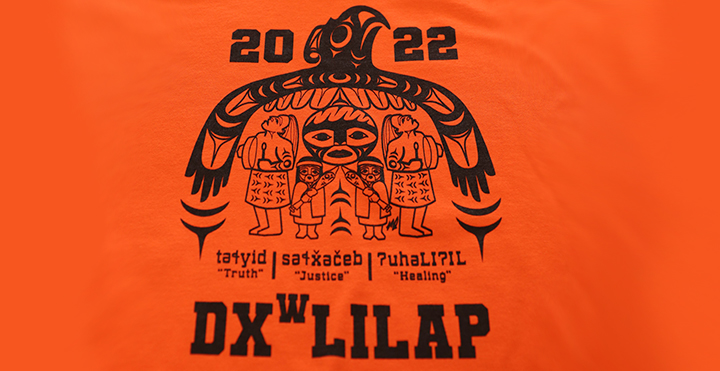
By Kalvin Valdillez, Tulalip News
In anticipation of their second annual community gathering to recognize Residential Boarding School Awareness Day, the Tulalip Education Division once again planned to hand out orange t-shirts on September 30th.
Last year, the Education Division reached out to Tulalip artist, Marysa Sylvester for the very first t-shirt design, which featured a hummingbird and a flower in traditional formline. Keeping true to their theme of supporting and promoting Tulalip artists, the Education Division commissioned this year’s design from Ty Juvinel.
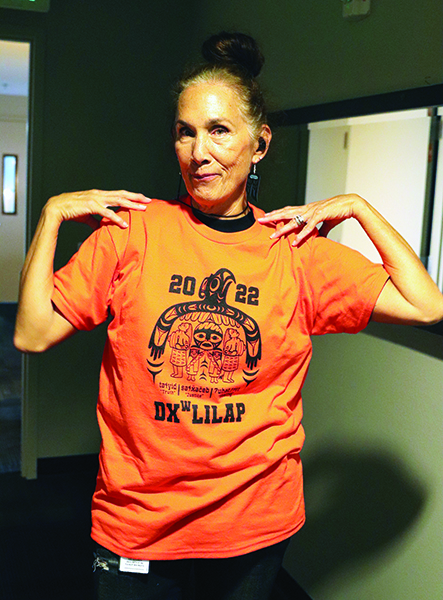
Leading up to the gathering, the design was kept under wraps and was set to be unveiled the day of the event. Hours prior to the ceremony, Tulalip News got an exclusive sneak peek at the design, which displayed the words truth, justice, healing in the traditional Lushootseed language. The design was leaked on the Tulalip News Facebook page and received a lot of heartfelt reactions and comments, and hopefully prompted many to take part in the annual gathering.
Said Ty, “The design represents a thunderbird and the creator watching over the community, with two warrior drummers watching over the children, and the children have their dance paddles showing they still have their heritage.”
Hundreds of t-shirts were handed out at the start of the ceremony, and together as a community, the people brought some truth, justice, and healing through traditional song and dance while proudly donning Ty’s design.
Truth and Reconciliation Day pop-up exhibit at Hibulb
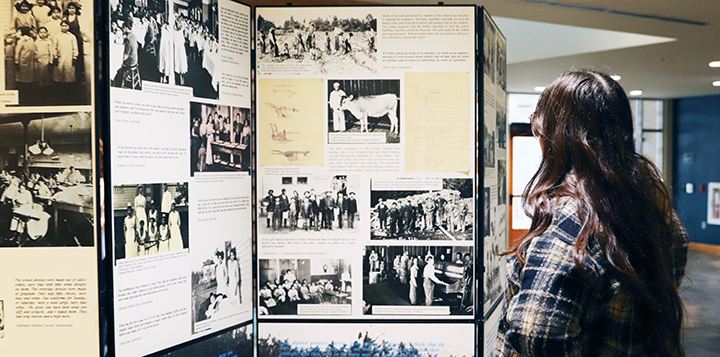
By Kalvin Valdillez
In recognition of Residential Boarding School Awareness Day, the Hibulb Cultural Center held a pop-up exhibit on Friday September 30 to help their visitors gain an understanding about the Indian Boarding Schools. The exhibit gave insight to what occurred at the terrible institutes of assimilation from the point of view of the Indigenous children who attended the Tulalip boarding school.
A heart-wrenching and tear-jerking screening of ‘The Faces of the Tulalip Boarding School’ played on a loop throughout the day inside the cultural center’s longhouse. The HCC giftshop also had a handful of orange t-shirts available for purchase in honor of the day of awareness. And a large double-sided panel was stationed at the center of the museum, which depicted black and white photos of the Tulalip boarding school and its students. Through letters sent home and a number of recorded interviews, the Hibulb Cultural Center compiled several testimonies from the Tulalip boarding school students, which painfully details what they experienced at the school.

Those dreadful recountings are positioned throughout the panel as captions to various photos. Below are some of those statements.
“The first night away from home seemed like a long, long night. At home, my mother would always go to the bedroom with me and lift me up. Sometimes my father would come to the door and tell me that I was a good girl. At school everyone put themselves to bed. The dormitories were always so cold. They had the windows wide open because they didn’t want us to get tuberculosis. Even in the winter they were wide open, and the cold wind blows over the bay.”
– Harriette Shelton-Dover, Snohomish
“I remember one of those majors, when there was an infraction of the rules, made the girls who went outside the boundaries line up and march in front of everyone in all three companies and get the back of their legs slapped with a ruler. And those girls couldn’t walk. It put scars on them.”
– Vi Hilbert, Upper Skagit
“At Tulalip you had to wear uniforms. They had a celluloid collar. I have a short neck and that thing would stick into my neck, so I’d always have to hold my head way up.”
– Ronomous ‘Toddy’ Lear, Lummi
“It was always meat and potatoes and ugly gravy. One doctor came along, and he changed things. He seen that a lot of us were getting sores around the neck, and he thought it was the diet.”
– Marya Moses, Snohomish
“We had to march from our rooms to the kitchen to eat and back again to get ready for school. And we’d march to the school building. Everywhere we went we’d march, march, march.”
– Ham Green, Makah
“I went to Tulalip. I was six years old. Mother didn’t like it very well, but she said it just had to be done. I felt bad when we was going., heck, along come a boat, a big motorboat, and picked us up. Like little cows, we got in and away we went. We didn’t even know where Tulalip was.”
– Woody Loughtey, Suquamish
“When the flu first came in 1917-1918m they were making coffins, but they couldn’t make them fast enough, so many people died. So, they wrapped them in tule mats, five or six in one grave.”
– Alfred Sam, Snohomish
The cultural center’s pop-up exhibit was a great introductory for those who wished to learn more about the boarding school era. Upon sharing the news about the exhibit on social media, many people who live out of the vicinity of Tulalip requested another pop-up so they can plan a visit in the near future. Several of those individuals expressed that they actually had relatives who attended the Tulalip boarding school and inquired how they could receive additional information and/or photos of their loved ones.
The Hibulb Cultural Center is open Tuesday – Friday 10:00 a.m. to 5:00 p.m. and Saturday – Sunday Noon to 5:00 p.m. For more information, including their exhibits and events, please visit their website www.HibulbCulturalCenter.org or contact (360) 716-2600.
Every child matters
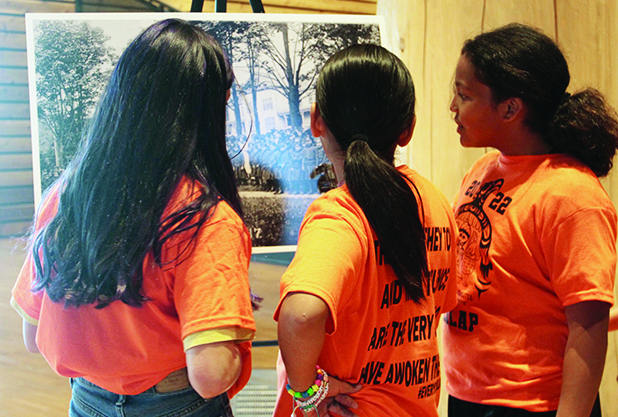
By Shaelyn Smead, Tulalip News
The Tulalip Education Division hosted their second annual Residential Boarding School Awareness Day. The evening commemorated the lost lives from residential boarding schools, and acknowledged the pain that the survivors carry with them every day. Some of the survivors shared their stories, family members spoke about the generational trauma that came from this era, and tribal leaders expressed how our community can move forward together.
Board of Directors Secretary, Debra Posey, spoke about how her grandmother was the first woman ever on the Tulalip tribal council in 1936. Long ago, they would pull their money together for gas, travel and to write letters to Washington DC, urging politicians and legislators to help our people. She spoke about how that same spirit and unity still lives in our people today through events like Residential Boarding School Awareness Day.
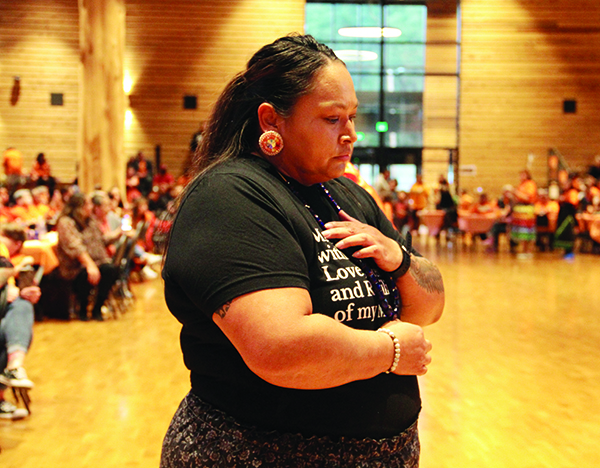
The emotional and heartfelt event was full of song and prayer to instigate healing and spiritual restoration. Tribal and community members wore orange to symbolize the day and show unity in efforts to raise awareness about these issues. And the phrase “Every Child Matters” was seen printed on items like earrings, t-shirts, and bags to remind those around us of the horrific acts that our families and ancestors once endured.
Throughout history our people have been silenced, demonized, and violated. Residential Boarding Schools are just another example of this horrific past and the grounds in which this country was built. The National Native American Boarding School Healing Coalition has identified more than 350 boarding schools that were operated by the US Federal government and the churches, from 1869 to the 1960s. Their philosophy being, “Kill the Indian, save the man.”
Native American children were forcibly taken from their homes and placed into these boarding schools intended to implement cultural genocide. Native children suffered various amounts of emotional, physical, sexual, mental and spiritual abuse. And in many cases, death. Children were no longer allowed to speak their native language, wear their traditional clothing, sing or dance, and partake in any of their cultural practices.
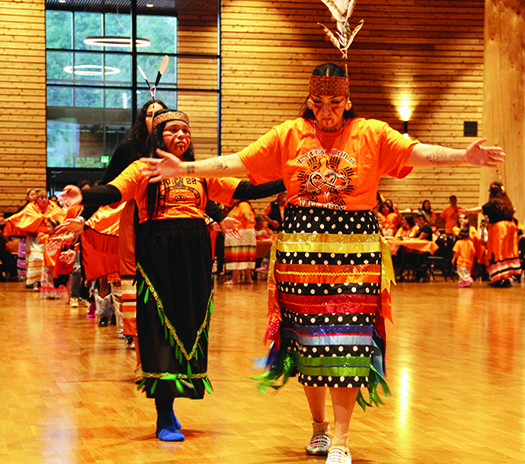
The US Interior Department has so far recognized 53 boarding school burial sites, both marked and unmarked. While the remains of our ancestors continually are found, the Interior Department acknowledged that these numbers will continue to grow as research continues. Today, 75 of the remaining boarding schools are still open, and 15 of them are still boarding.
This heartbreak is nothing new to our people, it is something that Indigenous people across the continent continue to feel and strive to overcome. Native Americans continue to fight and spread the word on this horrific era, and make the tragedies of our people known.
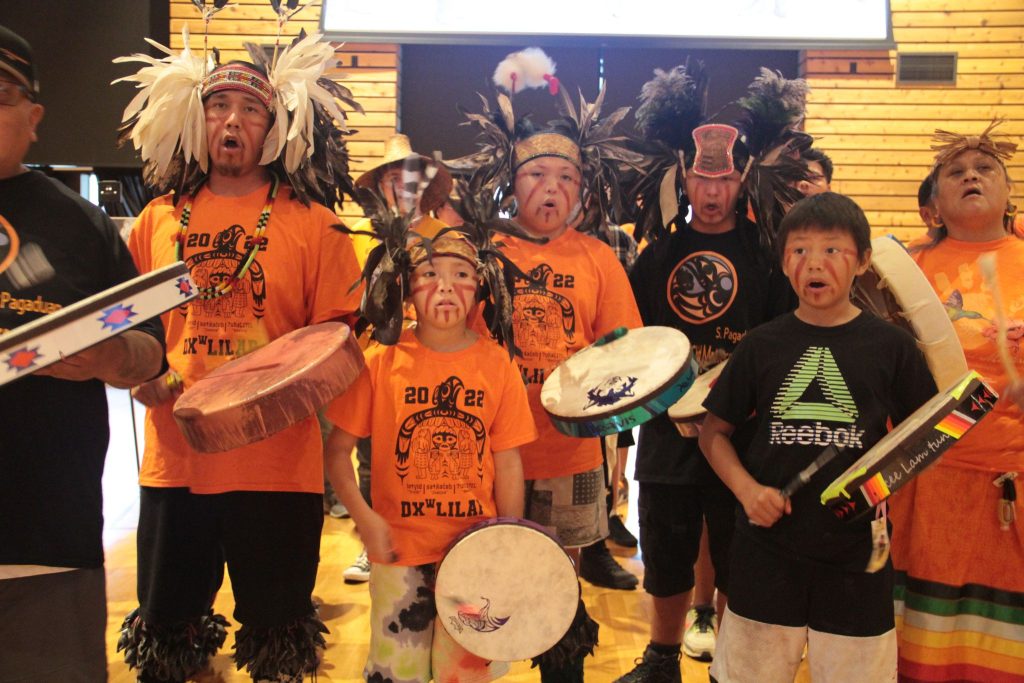
When speaking about the intentions behind Residential Boarding School Awareness Day, Youth and Family Enrichment Manager Josh Fryberg said “We come together to raise awareness about boarding schools, and to bring our people healing in the best way that we know how.”
For our people to be able to gather like we once did, to sing and dance, and honor our ancestors, it speaks to the level of perseverance that our people have and will continue to portray.
Audrina Bumgarner elevates Orange Shirt Day at her school

By Micheal Rios, Tulalip News
Youth-led. A common catch-all term used to describe events, efforts, or movements where youth are the face and first point of contact. However, it’s become rarer and rarer for such a thing to actually be true. More often than not, its adults pulling the strings from the background and projecting their virtues onto youth who are unable to describe the enormity of such grandiose concepts that their string bearers have bestowed upon them.
That isn’t to say youth-led efforts, in the truest sense of the term, don’t happen. Because they do. And when they occur they are usually noteworthy stories full of inspiration. Such is the case with 13-year-old Audrina Bumgarner and her commitment to seeing her school, Our Lady of Hope, recognize the National Day for Truth and Reconciliation.
More commonly known as Orange Shirt Day, September 30th has propelled itself into the mainstream because of Indigenous efforts all across North America. As Indigenous lore tells it, the day was created by Phyllis Webstad (Canadian First Nation) who tells the powerful story of having her orange shirt taken away when she attended a residential school, as well as being stripped of her language, culture and childhood joy.

“I went to the Mission for one school year in 1973-1974. I had just turned 6-years-old,” explained Phyllis. “I lived with my grandmother on the Dog Creek reserve. We never had very much money, but somehow my granny managed to buy me a new outfit to go to the Mission school. I remember going to the store and picking out a shiny orange shirt. It was so bright and exciting…just like I felt to be going to school.
“When I got to the Mission, they stripped me and took away my clothes, including the orange shirt. I never wore it again. [Since then] the color orange has always reminded me that my feelings didn’t matter, how no one cared and how I felt like I worthless. All of us little children were crying and no one cared.”
Phyllis’s words put literal truth to power as National Day for Truth and Reconciliation has since been adopted by both Canadian and U.S. governments to support the stories and memories of the children and generations lost during the Boarding School Era.
With this powerful sentiment in mind, young Tulalip citizen Audrina approached her catholic school’s leadership staff several weeks ago with a simple request: formally recognize Orange Shirt Day by allowing the school’s Tulalip students and their fellow student allies to be exempted from the school’s uniform dress code in order to proudly wear orange. After consideration, the school honored the request.

“Our student council has been focused on several projects this year. One of those projects was created by Audrina who wanted us to recognize Orange Shirt Day in a bigger way than we have ever done in the past,” said Our Lady of Hope principal Kathy Wartelle. “She came with a complete plan that felt empowering to her and her community, while also being beneficial to teaching others about the day’s significance.
“It’s incredibly important that we, as a school, support our students of multicultural backgrounds,” she added. “We love the diversity that our school has and have develop a great relationship with the Tulalip Tribes. We have close to 50 Tulalip students attending this year, so it’s important that we continue to learn from one another and our families. This means recognizing the impacts of past discretions have had on all cultures and using our faith to lift each other up.”
With the support of Our Lady of Hope’s leadership, Audrina elevated Orange Shirt Day to new heights and led her fellow Tulalip peers in proudly wearing their culture on their impossible to miss, bright orange shirts. For students who wanted to support the movement but didn’t own an orange shirt, the administrative staff hand crafted orange ribbons that could be pinned to the students’ uniform.
As students took to their seats in preparation of the school day, Audrina took to the school-wide microphone with a heartfelt message intended to educate those within the private catholic school who may have been unaware of day’s significance.
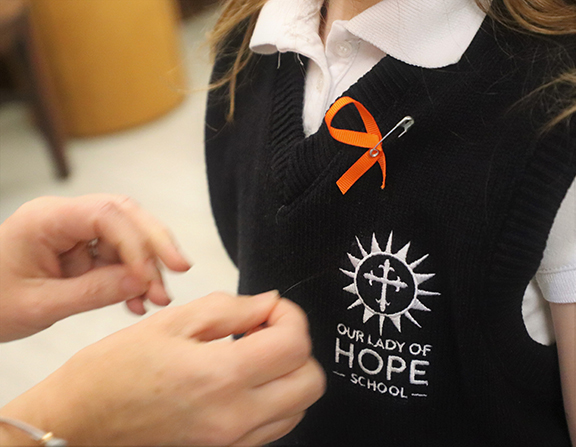
“Orange Shirt Day is in recognition of the lasting trauma these Indian Residential Schools caused to survivors and their families and Native Americans to this day. This is a day for healing and to remember the children who didn’t come home. On this day we pray for healing,” declared the inspirational Tulalip youth.
While her words resounded throughout the classrooms and hallways of the Everett-based school, her well-intentional effort came to fruition in the hearts and minds of her peers and teachers who not only took in her message, but also weren’t afraid to showcase their support by wearing orange.
“Last year, only me and a handful of other students wore orange. The awareness wasn’t really there, so I wanted to make it more recognized and bring more awareness to the day this year,” explained the 13-year-old while. “Orange Shirt Day is a day of remembrance to honor the children who didn’t come home and also the children who did come home because the survivors and their families are still affected to this day.”
Following Audrina’s school-wide announcement, Dion Joseph, father of Our Lady of Hope students Gia and Kingston Joseph who rocked their Every Child Matters orange swag to school, summed up the day’s youth-led development perfectly. “It means a lot because not only are our kids honoring their ancestors by going to school to get an education, but they also are educating and bringing awareness to others about the true history of our people and the true history of European people. It makes me proud to know those truths are no longer being swept under the rug.”
